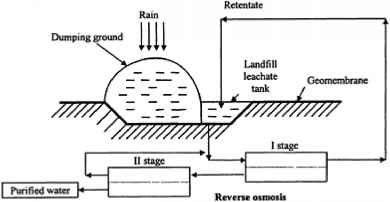Examples of Reverse Osmosis Application to Landfill Leachate Treatment Plants
Figure 16 presents the diagram of a reverse osmosis system used in the treatment of landfill leachate from the dump at Wijster in Holland and at Rastorf in Plön, Germany [77,89]. Both plants consist of two stages: the first stage is equipped with tubular modules and the second with spiral-wound modules. Theretentatefrom the first stage is returned to the landfill and the permeate is treated in the second stage. The retentate from the second stage is recycled to stage one and the permeate is discharged. The leachate is prefiltered and the pH is adjusted before thereverse osmosis membranes, but there is no other pretreatment. The operating parameters are presented in Table 12 [77].
The retention of pollutants is very good. For example, the retention of COD and NH4+-N is higher than 99% at the Rastorf plant. After a few years of exploitation, a four-stage evaporation plant has been commissioned with a steam-drying plant to treat the reverse osmosis retentate at the plant at Rastorf. The granulate from the steam-drying plant is now transported to a special waste depot. Table 13 provides data demonstrating the effectiveness of this system according to Rautenbach [91] and Table 14 does likewise, according to Mulder [89].
Using ROCHEM disc-tube module (DT-module) and the adequate membrane optimized results, different landfill leachate treatment plants were installed in Germany in the period 1988-1993 [79,81,82,99], that is:
• Schwabach (1988): two RO stages with DT-modules;
• Ihlenberg (former Schönberg) (1990): 36 m3/hour feed capacity (reverse osmosis as main step of a landfill leachate purification process avoiding any wastewater, the most modern and largest multistage plant that has been built to date for this application);
• Kolenfeld (1990): plant with two stages with DT-module, ca. 30m3/day feed capacity;
• In 1991 plants started operation at the sites of Wiershop, Susel, Lochau, Höfer, and further systems in Schönberg.
• In 1992 systems were installed in Lüchow-Dannenberg and Burgdorf.
-

- Figure 16 Diagram of landfill leachate treatment with the use of reverse osmosis. (From Refs 78-90.)
Table 12 Operating Parameters for Two Commercial Reverse Osmosis Plants Treating Landfill Leachate
Rastorf___Wijster
Table 12 Operating Parameters for Two Commercial Reverse Osmosis Plants Treating Landfill Leachate
Rastorf___Wijster
Treated leachate (m3/day) |
70 |
1056 |
||
总减少渗滤液volume (%) |
71 |
54 |
||
Conductivity of the feed (mS/m) |
1500 |
2500 |
||
Stage one |
Stage two |
Stage one |
Stage two |
|
Membrane area (m2) |
210 |
120 |
1702 |
691 |
Temperature (°C) |
30 |
30 |
25-30 |
25-30 |
Pressure (MPa) |
3 |
2 |
4 |
5 |
Flux (L/m2/hour) |
15-18 |
30 |
18 |
34 |
Membrane lifetime (year) |
1.5 |
2 |
2 |
3.5 |
Source: Refs 77, 89.
Source: Refs 77, 89.
The data presented in Table 15 show some examples for the plant with two stages at Schwabach [81,82,99].
反渗透的成功操作plant of the municipal waste landfill of Ihlenberg is an example that has been realized for landfill leachate purification. With two-stage RO, the rejection for salts and organic contaminations is about 99% (Table 16) [81,95]. Depending on salt content in the feedwater and operating time between cleaning cycles, operating pressure ranges between 3.6 and 6.0 MPa with a specific permeate flux amounting to 15 L/m2hour can be achieved.
Similar results are reported from other plants. Table 16 presents typical plant performance in leachate purification using DT-modules. These data covering long-term experience have also been confirmed by the results of more than 150 other systems in operation on different landfills worldwide [99].
Table 13 Treatment Effectiveness of Landfill Leachate With the Use of Reverse Osmosis
Parameter_Raw landfill leachate Permeate Retention coefficient (%)
Table 13 Treatment Effectiveness of Landfill Leachate With the Use of Reverse Osmosis
Parameter_Raw landfill leachate Permeate Retention coefficient (%)
PH |
8.6 |
5.25 |
- |
Conductivity (pS/cm) |
17,700 |
314 |
98.23 |
COD (mg/L) |
2,560 |
21 |
99.18 |
BOD (mg/L) |
65 |
0.6 |
99.08 |
NH4+ (mg/L) |
465 |
6 |
98.71 |
Cl- (mg/L) |
4,219 |
72 |
98.71 |
SO42- (mg/L) |
2,800 |
12 |
99.57 |
Ca2+ (mg/L) |
160 |
2.1 |
98.69 |
Zn2+ (pg/L) |
220 |
100 |
54.55 |
Cu2+ (pg/L) |
640 |
28.8 |
95.50 |
Pb2+ (pg/L) |
20 |
5 |
75.00 |
Cd2+ (pg/L) |
<10 |
1 |
>90 |
Hg2+ (p/L) |
<1 |
0.6 |
>40 |
Table 14 Effectiveness of the Two-Stage Osmosis System for the Treatment of Landfill Leachate at Wijster (Holland)
Parameter Raw landfill Permeate from second stage of System effectiveness leachate__reverse osmosis__(%)
Table 14 Effectiveness of the Two-Stage Osmosis System for the Treatment of Landfill Leachate at Wijster (Holland)
leachate__reverse osmosis__(%)
BOD (mg/L) |
60 |
2 |
93.7 |
COD (mg/L) |
1600 |
8 |
99.5 |
Nitrogen (mg/L) |
480 |
10 |
97.4 |
Chloride (mg/L) |
2250 |
45 |
97.9 |
pH |
8.2 |
5.6 |
- |
Capacity (m3/hour) |
35 |
27 |
Source: Refs 78, 89. The results prove that reverse osmosis is a very effective instrument for the purification of landfill leachate, if all design criteria and requirements specific to landfill leachate have been taken into consideration and an adapted module system is used. |
Continue reading here:Treatment of Reverse Osmosis Retentate
Was this article helpful?
